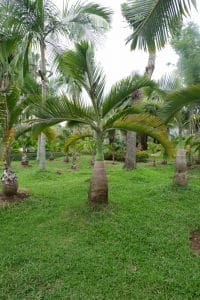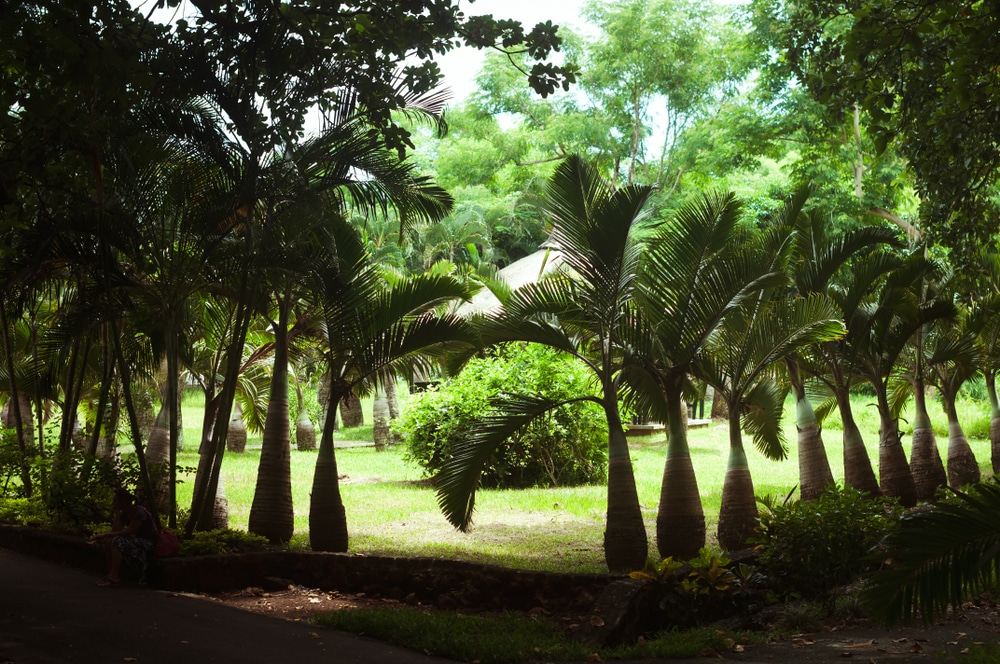A true palm species within the Arecaceae family, the Bottle Palm has typical fronds sprouting on top of its bottle-shaped trunk.
| Botanical Name | Hyophorbe lagenicaulis |
| Common Name | Bottle Palm |
| Plant Type | Perennial |
| Flower Color | White flowers on top of stalks |
| Size When Mature | 96 to 180 inches |
| Bloom Time | Spring or summer |
| Sun Requirements | Full sun to Partial sun |
| USDA Hardiness Zones | 4 to 11 |
| Soil PH Range | 6.0 to 8.0 |
| Soil Type | Sandy, well-draining |
| Water Needs | Medium |
| Native Area | Mascarene Islands |
What you Need to Know About The Bottle Palm Tree
The Bottle Palm is easily recognized with a thick trunk that’s shaped like a bottle. The tropical plant grows limited fronds and feather-shaped leaves that arch beautifully to the heavens. Hyophorbe lagenicaulis is slow-growing and doesn’t require much watering once established.
It’s worth noting that Bottle Palm has white flowers sprouting on top of long and thin stalks in warmer months. The blooms stay for around a week or so before turning into green berries that turn black when ripe. Growing requirements for a bottle palm are fairly simple- just give it full sun and water when the soil is dry, and the palm will beautify your landscape for years to come.
How to Care for the Bottle Palm
Here’s everything you need to know about growing and caring for a thriving Bottle Palm Tree
Light
Like all other palm varieties, the Bottle Palm grows best in areas that get full sunlight. In your yard or garden, you should find a spot that gets a minimum of six hours for your bottle palm to thrive.
Conversely, the bottle palm can still survive being in a partial sun environment. Indoors, the palm species must be in a window that faces the south in order to grow normally and become healthy.
Indoors and on patios the bottle palm only grows to around 8 feet, but it can grow up to 15 feet outdoors and when planted in the ground.
Even in a full sun environment, the palm does not grow quickly. However, you can look forward to stunning white flowers once the plant is mature and during the growing season.
Water and Soil Needs
The Bottle Palm plant will want loose, sandy, and well-draining soil that allows water to pass through fairly quickly. Most palm trees live in the wild on sandy beaches, and the bottle palm is no exception.
You can mix garden soil or topsoil that has a generous amount of sand, along with organic compost to make up the medium for your plant. It has to be well-draining, and if potted, there must be adequate drainage holes at the bottom.
It’s worth noting that you should keep the soil constantly moist in the early stages. After the bottle palm has acclimated and matured you won’t have to irrigate as much. The plant can take short droughts but it will still need to be watered on hot days.
Temperature Requirements
Hyophorbe lagenicaulis can grow in USDA zones 4 through 11. In colder zones 4 through 9 it will be better to grow bottle palm as a houseplant, while those who live in zones 10 and 11 can plant the palm variety in their yard.
The Bottle Palm tree tolerates hot environments well, but it’s weak against frost. In areas that experience 30 degrees F or below it’s recommended that you bring your plant inside.
Fertilizer
The best fertilizer to use on a Bottle Palm is one that has a high potassium content. Alternatively, you can feed your palm tree a specially formulated product designed for palms in particular.
You can feed your bottle palm a slow-release granular mix since it’s a slow grower and doesn’t need too many nutrients in one go. If the soil is already amended with organic mulch or compost then you won’t need to feed again in the current growing season.
Remember to follow manufacturer instructions to avoid fertilizer burn and yellowed fronds.
Common Diseases
In general, palm trees can be affected by fusarium wilt, a fungal disease that leads to brown or discolored and crinkly fronds. The other enemy of a bottle palm is extreme cold- it can only take up to 30 degrees F before shedding its leaves and starting to show frost damage.
The best way to combat palm pests and diseases is to spot them early and take the necessary steps to fix the problem. While planting, make sure that the soil drains easily and won’t be waterlogged in heavy rain. A fungicide spray can deal with fusarium wilt and similar conditions. You can also spray organic insecticide to combat thrips, palm budworm, and palm borers.
The Bottle Palm Propagation
The Bottle Palm is a true palm variety and therefore may only be propagated by seed.
In its growing season, Hyophorbe lagenicaulis tends to produce white flowers that turn into small green berries in a span of a few weeks. The green berries turn completely black as a sign that they’re ripe- you can eat the edible fruit and store the seeds for later.
You can start the seed indoors and plant it in a small container. It takes around 4 to 6 weeks for bottle palm seeds to germinate. Plant it at a shallow depth, and with the top peeking a bit at the top of the soil. Mist regularly to keep the soil moist and in a warm environment.
Related Article: Zone 6 Palm Trees


